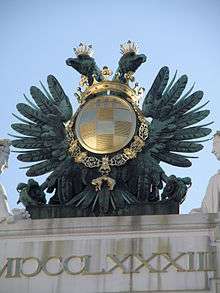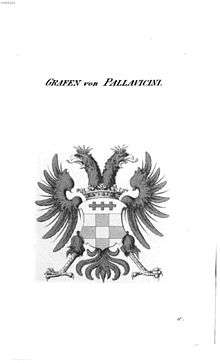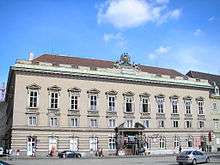Pallavicini family
The Pallavicini, Pallavicino, and in former times named "Pelavicino", are an Italian noble family descended from Oberto I (died 1148). The first Pallavicino fief was created by Oberto II, who received it from Frederick Barbarossa in 1162. A number of lines descended from Guglielmo (died 1217), possessor of a series of fiefs between Parma and Piacenza and a descendant of the Lombard Obertenga family (along with the Este, the Cavalcabò and Malaspina). They are:
- The Pallavicini of the Latin Empire
- descendants of Guglielmo through his sons Guy (also known as Galdo) and Rubino
- The Pallavicini of Lombardy
- The Pallavicini of Varano
- The Pallavicini of Polesine
- The Pallavicini of Busseto
- The Pallavicini of Ravarano (today part of Calestano)
- The Pallavicini - Rospigliosi family of Tuscany and Rome
- The Pallavicino of Sicily

A second main branch of the family (or perhaps a separate family) was formed by the descendants of Niccolò Pallavicini (alive in 1154), whose origins are doubtful—probably he belonged to the Genoese patriciate—and whose links with the Obertenghi are uncertain:[1]
- The Pallavicini of Genoa (patricians of Genoa)
The Pallavicini of the Latin Empire
Through Guy and his brother Rubino, a branch of the family rose to prominence in the Latin Empire founded after the Fourth Crusade in 1204.
They governed the Margraviate of Bodonitsa from 1204 to 1358. They grew in riches and, after 1224, became also the most powerful family in the former Kingdom of Thessalonica (northern Greece). The first margraves were of Guy's line until his daughter Isabella died, at which time the line of Rubino inherited the throne. The Pallavicini were related to the De la Roche family then ruling in Athens. After the death of Albert in 1311 the Pallavicini influence slowly declined. The subsequent Zorzi margraves were matrilineal descendants of the last Pallavicini marquise, Guglielma.
Notable members

- Guglielmo Pallavicino (Pallavicino) (died 1217)[2]
- Oberto I Pallavicino
- Oberto II Pallavicino
- Guy (died 1237)
- Oberto Pelavicino (1197–1269)
- Ubertino (died 1278)
- Isabella (died 1286)
- Thomas (born before 1286, died after 1331), margrave of Bodonitsa, grandson of Rubino
- Albert (died 1311)
- Guglielma (died 1358)
- Orlando (sometimes Rolando) “il Magnifico” (c.1393–1457)[2]
- Sir Horatio Pallavicino (c. 1540 – 1600), merchant, financier, and diplomat in England
- Benedetto Pallavicino (c. 1551 – 1601), from Cremona, composer
- Francesco Sforza Pallavicino (1607–1667), historian and cardinal
- Ferrante Pallavicino (1618–1644), Italian writer
- Carlo Pallavicino (c. 1630 – 1688), composer
- Stefano Benedetto Pallavicino (1672–1742), Italian poet and opera librettist
- Lazzaro Opizio Pallavicino (1776–1777), Camerlengo of the Sacred College of Cardinals
- Gianluca Pallavicino, general and governor of Lombardy (second half of 18th century)
- Emilio Pallavicini (1823–1901), general and senator who defeated Garibaldi at the battle of Aspromonte
- Johann, Markgraf von Pallavicini (1848–1941), Austro-Hungarian diplomat
- Benjamín Solari Parravicini (1898–1974), Argentine artist and prophet
- Marchesa Anna d'Androgna Parravicini, (1840-1922) Noblewoman and patron of the arts
- Markgraf (Őrgróf) Tamás Csáky-Pallavicini (1960- ), Secretary General of the World Federation of Catholic Medical Associations in the Vatican[3]
- Karen Akers (born Orth-Pallavicini) (1945-), American actress and singer
See also

A number of buildings are named after the family:
- Palais Pallavicini in Vienna, Austria
- Palazzo Pallavicini-Rospigliosi in Rome, Italy
- Villa Durazzo-Pallavicini near Genoa, Italy
- Palazzo Pallavicini in Bologna, Italy
- Villa Gandolfi-Pallavicini in Bologna, Italy
- Palazzo Pallavicino in Parma, Italy
Businesses owned and operated by the members of the Paravisini American family (through the Paravisini-Pallavicini Italian family distantly related to the Pallavicini dynasty):
- Paravisini Coffee Company in Rhode Island, USA.[4]
- List of titled noble families in the Kingdom of Hungary
Notes
- Pallavicini (in Italian) from the Genealogie delle famiglie nobili italiane at sardimpex.com.
- Pallavicino (in Italian) from the Genealogie delle famiglie nobili italiane at sardimpex.com.
- "F.I.A.M.C. – Fédération International des Associations de Médicins Catholiques / World Federation of the Catholic Medical Associations". www.fiamc.org.
- "Paravisini Coffee Company". paravisinicoffee.com.
Sources
| Wikimedia Commons has media related to House of Pallavicini. |
- Miller, W. "The Marquisate of Boudonitza (1204–1414)." Journal of Hellenic Studies, Vol. 28, 1908, pp 234–249.
- Setton, Kenneth M. (general editor) A History of the Crusades: Volume III — The Fourteenth and Fifteenth Centuries. Harry W. Hazard, editor. University of Wisconsin Press: Madison, 1975.
- Cawley, Charles, Latin Lordships of Greece: Boudonitza., Medieval Lands database, Foundation for Medieval Genealogy,
- Marquisate of Bodonitsa
